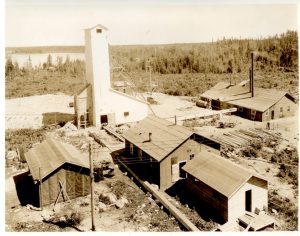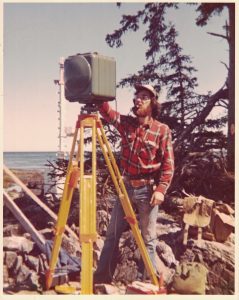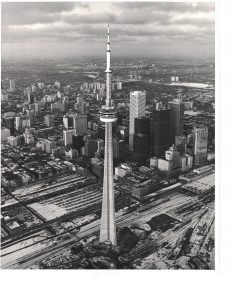The First 150 Years of Civil Engineering in Canada
As Canada celebrates 150 years, we reprint an abridged lecture given by Robert F. Legget in 1977 —in honour of the University of Toronto’s 150th anniversary—with commentary provided by Professor Brenda McCabe in 2017. Click here to read the entire transcribed lecture.

Back in 1827 – the same year as the founding of the University of Toronto – travel was mainly by water but a network of simple roads did exist between the main settlements, often impassable but when in good repair sound enough to permit of the operation of simple horse-drawn wagons.
Although it was possible to travel by stage coach from Montreal to York, when the road was not impassable, the more usual way of making this long journey was by stage coach. Starting the nine miles on the road to Lachine; by boat across Lake St. Louis to Cascades; then a coach again to Coteau du Lac; on board another vessel for the journey to Cornwall; on shore again for a drive to Prescott; and then finally the long sail out by steamboat to the safe harbour of York on Lake Ontario.
North of the lake, once the shoreline settlements were left far behind, one found oneself among the great trees of virgin forests. Beyond the forests was still the land of the Indigenous peoples, penetrated only by intrepid voyageurs in their hunt for furs. In the fledgling settlements, lighting was still by oil or candles. All power was man- or horse-power, apart only from that available from the first water- and wind-mills. Fuel was from the nearby forests.
Surveying had started and the first land subdivisions had been made. Construction was underway on building homes and wharves, simple and imperfect roads, the small timber bridges and there were significant starts on canals, the Welland Canal. What changes the intervening 150 years have seen!
Consider briefly what has happened to the face of Canada in the space of just two generations. Despite its size all of Canada has now been seen from the air and photographed. Our northern regions have been surveyed and measured, to a scale of 1:250,000, and the southern part of the country at 1:50,000. Well over half a million miles of roads and streets now serve the entire southern part of the country. A splendid Trans-Canada Highway runs from coast to coast. A network of over 44,000 miles of railways still serves vital transport needs. The Intercolonial Railway and the Canadian Pacific Railway span the country uniting the early separated colonies in an almost mystical way. Two railways reach the shores of Hudson Bay. One line goes north of the 60th parallel; and in the Yukon, the White Pass Route still gives Whitehorse its link with the sea. Magnificent bridges, some of them world famous, serve both railways and roads.
Telegraph lines parallel road and rail across the land, linked with overseas cables beneath Atlantic and Pacific, their service now supplemented by familiar and frequent steel microwave towers. Almost 20,000 miles of gas and oil pipelines, hidden from view but providing vital media for fuel supplies. Airports throughout the land, of special significance in northern regions where the Inuvik runway continues to give splendid service to the largest planes even though founded on the worst of permafrost and muskeg. The airfields served by a variety of terminal buildings, large and small.
Twenty-five fine deep-water ports on Atlantic and Pacific coasts, as well as up the St. Lawrence, are vital links to worldwide trade. A great dredged channel enables large ships to sail up the St. Lawrence Seaway. This allows ocean-going vessels to penetrate the heartland of North America. In the west, irrigation systems assist in the progress of agriculture. Dams provide reservoirs for irrigation, for water supply and flood control, and above all for power generation. All these facilities are to serve the more than 23 million Canadians, of whom almost 80 per cent live in cities. All cities and towns now have public supplies of clean water for all citizens. All but the smallest inland towns now have sewer systems; many but by no means all, have treatment plants for processing wastewater before returning to natural waterways. Large cities have other underground services such as telephone circuits, high-pressure water for fire fighting, and gas mains. Networks of tunnels beneath city streets for mass transit and above ground we have great and beautiful buildings, some vast, some tall including the tallest building in the Commonwealth, and, in splendid, but puzzling isolation the CN Tower.
In more recent years, the mechanical engineer made great contributions especially in the steady development of power supply and transportation; mining engineers have been responsible for the development of mines; electrical engineers for the many applications of electricity for practical use; chemical engineers now playing their special role in the process and chemical industries. Civil engineers form part of a well-integrated team.
In earlier days, there were no divisions of engineering; there was military engineering and there was civilian engineering. Since then, it has been the civil engineer who has still been responsible for “changing the face of the land”, working with his fellow engineers in the equipping of his structures and associated with architects in the design of buildings.
I think first of the hundreds, rather the thousands of civil engineers who served loyally their better known Chiefs – the surveyors, the resident engineers, the construction superintendents, often working in relative isolation, often in danger in earlier days, usually far removed from the conveniences of urban living, but carrying great responsibilities.
The record of civil engineering in Canada is not an unbroken success story. Mistakes were made, some serious ones. The failure of the Transcona Elevator when first it was filled with grain, tilting almost 40° before it came to rest, was one of the most spectacular building failures that the world has ever seen but restoring it to a vertical position showed the world also the skill of Canadian civil engineering contractors.
Then there are those who equate civil engineering with ugly structures. Admittedly, there are some structures that fail to blend with the landscape and add no beauty to it. In my opinion, these constitute a small minority. On the other hand, one thinks rather of elegant and graceful bridges. Many powerhouses, through the combined work of civil engineers and architects, are truly noble buildings. And some were greatly impressed with the beauty in the West, of the grain elevators, with their white domes and towers, which carry the eye from the immense prairie levels to the blue prairie sky.
There are also strongly voiced criticisms of civil engineers for “spoiling the environment” with strange implications that it is the civil engineers who are somehow responsible for the pollution of waterways with sewage, to take but one example. Engineers have long known how to purify all liquid wastes but they can only apply that knowledge if those responsible, in industry and in government, so direct and are willing to pay the cost. The city of London, England, demonstrated what can be done by civil engineers, if the leadership is there, by the cleaning up of the River Thames. Canada has still far to go, in cleaning up the Great Lakes and the Ottawa River to give just a couple examples.

Interest in the protection of the environment is welcome but public concerns must be well informed and based on fact rather than emotions. Some public comments on our waterways, would suggest that civil engineers have done nothing about flood protection and are blamed for not “doing something” long ago. Have those critics heard of the Quebec Streams Commission, world renowned in the 1920s-1930s as a pioneer water conservation agency or the River Valley Conservation Authorities of Ontario whose work has been in both the design and construction of water control projects.
The future has inevitably come up for mention; how could it be otherwise? Almost all the works of civil engineers are planned and designed with future needs always in view. Their prime objective is to provide those physical services for people that are essential for modern living. In all civil engineering anticipating the needs, number and distribution of future people.
The turn of the century is less than twenty three years away. Why do I suggest so limiting our future thinking? Because we can today anticipate some disconcerting developments which will almost certainly be here by 2000 if not before. It now seems certain that the ·population of the world will be about seven billion by the end of the century, double that of 1970. Some experts predict that world starvation will limit total growth beyond this; some say this could occur even before the close of the century.
But that there will be a substantially larger population in Canada by the end of the century is certain, with well over eighty-five per cent living in urban areas. Linked with such changes is the prediction that electric load is expected to double by 1983. and may redouble by 1993.
Quadrupling of power supply well before the end of the century raises another set of questions, especially when it is realized that the United States “uses more energy for air conditioning alone than 800 million Chinese use for all purposes (and) Canada is part of this same syndrome”. The use and supply of materials, non-renewable natural resources, further illustrate the profligate society in which we are living.
The world of 2000 will be very different from today. The vast problems that can be seen ahead will be overcome but the profligacy of our present society must be curbed. There are limits to growth and the sooner we realize this the better. Here is where we must distinguish between our duty as privileged and informed citizens with corresponding special responsibilities, and as civil engineers. In this article we are concerned with the contributions of civil engineering to Canada.
Remembering this, let us consider just the needs of Canada itself. Civil engineers will continue to be responsible for the construction of urgently needed power plants and of the means of handling fossil fuels, improved railways and waterways for coal and pipelines for gas and oil. More mundane but equally important is the many treatment plants, supplementing new water supply systems, so that our waterways may be conserved for all time while being well used. Other urban services will call for improvement and extension, always with due regard for the amenity of “city-scapes”, all possible services being placed underground. Engineers will have special responsibility for protecting the fragile environment of the far North of our country, something that Canada must ensure without question.
These are challenging prospects. Many involve underground work. Remember also that every structure depends for its safety and stability upon the ground on which it rests and thus the importance of geology in all work will be evident. No two foundation problems are ever the same. Judgement is required in every case for the final decision as to the suitability of the ground to serve as foundation bed, as a material of construction, or for excavation. And no computer ever exercised judgement.
Civil engineering must, therefore, continue to depend for its excellence upon well-trained men and women who are willing to gain experience the hard way, on the job, that experience upon which alone sound judgement can be based. This requires, the very best training by experienced instructors , who can introduce their students to a new techniques, new methods, new approaches to old problems. And who can inspire an appreciation of their high calling, of the heritage of their profession.
As we face the unknown of tomorrow, we would do well to look backward, as this anniversary gives us pause to do, to be inspired by the examples of our profession’s past; to make every possible use of the accumulated experience of all who have gone before; to realize that every step forward is a small part in the long tradition of civil engineering and to improving this wonderful land of Canada.
A 2017 perspective by Professor Brenda McCabe
One can only be impressed by the history of Civil Engineering in Canada. Mr. Leggett’s story warms the hearts of us all. During Canada 150, I hope you can take a detour to visit some of the country’s iconic Civil Engineering sites. Having had the opportunity to travel the length of the Rideau and Trent-Severn Canals, I can attest to the ingenuity and longevity of those incredible water highways. Even today, some of the valves, lock doors and swing bridges along the canals are operated manually. It serves as a reminder of how clever engineering can last longer than a lifetime.
The world is a different place than it was when Leggett gave his insightful lecture 40 years ago. While we are still constructing important transportation, energy, water, and building infrastructure systems, those projects seem bigger and more complex today. New technologies are being introduced at a pace unseen before. Our perspective and responsibilities are growing as we engage more stakeholders in critical decision making, including First Nations. Our goal is not just to build, but to ensure that future generations may also benefit from living in a country of extraordinary people, opportunities, and natural resources.
The civil and mineral engineering classrooms are also changing. Enrollment of women in first year has reached 40 per cent two years in a row! The fundamental tenets of theory and practice remain. Engineering is an applied science and experiential learning is key to the making of a great engineer. For nearly 100 years, Survey Camp has provided civil and mining/mineral students with immersive, hands-on learning about measurement, teamwork, and engineering sensibility. In addition to the array of technical courses, students are learning about social responsibility, leadership, and entrepreneurship.
It would be interesting indeed to read a history of our next 150 years as Canada continues to develop and take leadership roles on the world stage. Hopefully, it would be just as exciting, and celebrate more engineers with the skills and motivation to champion and lead our great country.

